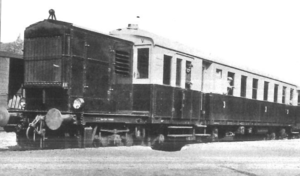Osterwieck-Wasserleben Railway T 04
| OWE T 04 | |
|---|---|
|
original state
|
|
| Numbering: |
OWE : T 04 DR : 137 551 |
| Number: | 1 |
| Manufacturer: | LHW |
| Year of construction (s): | 1929 |
| Retirement: | 1969 |
| Type : | Bo'2 'de |
| Genre : | BCPw4ivT |
| Gauge : | 1435 mm ( standard gauge ) |
| Length over buffers: | before conversion: 21,950 mm after conversion: 22,300 mm |
| Height: | 3,850 mm |
| Trunnion Distance: | 14,650 mm |
| Bogie axle base: | 2,600 mm |
| Total wheelbase: | 17,150 mm |
| Service mass: | 43,000 kg |
| Top speed: | 80 km / h |
| Installed capacity: | 154 kW (210 hp) |
| Motor type: | Four-stroke diesel engine |
| Rated speed: | 1,100 rpm |
| Power transmission: | electric |
| Brake: | Compressed air brake type Knorr |
| Seats: | 60 + 6 folding seats |
| Floor height: | 1,240 mm |
| Classes : | 2nd / 3rd |
The OWE T 04 railcar was a vehicle of the Osterwieck-Wasserleben Railway .
It was procured as a towing car especially for operation on the Wasserleben – Börßum line , as the T 01, which was converted from a two-axle passenger car in 1930, could no longer cope with operation on its own. The railcar resembled the Saxon DET 1–2 in its exterior .
history
The railcar was bought by the Osterwieck-Wasserlebener Eisenbahn in 1934. Where it came from is unknown. With the purchase of the railcar, the company was able to do without locomotive-hauled passenger trains entirely. The T 04 proved to be superior to its predecessor in terms of performance and carried the bulk of the tourist traffic. The railcar was preferably stationed in Osterwieck .
During a renovation in 1937/38, the railcar was given a modern exterior.
DR 137 551
After the route was split as a result of the Second World War, the railcar remained in the inventory of the Reichsbahndirektion Magdeburg . It was taken over by the Deutsche Reichsbahn in 1949 as VT 137 551 and was active in operational service until 1964.
He was sighted here on January 1st, 1950. From January 1, 1955, he was stationed in Stendal . Usage data can no longer be determined. The vehicle was parked on November 20, 1964, and was taken out of service in 1969.
technical description
Originally, the machine system housed in the machine bogie, consisting of the diesel engine and the main generator, was located in front of the car body.
During the remanufacturing after an accident in the mid-1930s, the car body was slightly lengthened and the machinery was placed under the floor in the machine bogie. The length over the buffers increased by almost one meter. The electric traction motors were housed in the motor bogie on the other side of the car.
literature
- Dirk Endisch: Small and private railways in the northern Harz foreland. Verlag Dirk Endisch, 2004, ISBN 3-936893-11-X .
- Andreas Knipping: The 6000 series of the Deutsche Reichsbahn. EK-Verlag 2001, ISBN 3-88255-160-7 .
See also
Individual evidence
- ↑ Dirk Endisch: Small and private railways in the northern Harz foreland. Verlag Dirk Endisch, 2004, ISBN 3-936893-11-X , p. 27.
- ↑ Dirk Endisch: Small and private railways in the northern Harz foreland. Verlag Dirk Endisch, 2004, ISBN 3-936893-11-X , p. 30.
- ↑ Andreas Knipping: The 6000 series of the Deutsche Reichsbahn. EK-Verlag, 2001, ISBN 3-88255-160-7 , p. 317.
- ↑ Dirk Endisch: Small and private railways in the northern Harz foreland. Verlag Dirk Endisch, 2004, ISBN 3-936893-11-X , p. 59.

